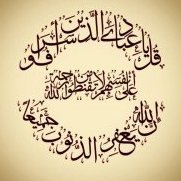Search the Community
Showing results for tags 'language'.
-
Vowels and Consonants The prominent view amongst the Grammarians is that the Arabic Alphabet has 28 letters [1], and they are all consonants. There are 3 short vowels which are separate from the Alphabet (they are the markings on the letters), and vowels are needed to pronounce words. So a vowel in Arabic is called a حَرَكَة (haraka), and the plural "vowels" is called حَرَكَات (harakāt). In the English, the vowels are 5 (A, E, I, O, U), whereas in Arabic the vowels are 3: 1. Ḍammah (ضَمَّة) which looks like this _ ُ _ and that little Dammah is written above the consonants (i.e. Letters of the Arabic Language), which is pronounced as 'o' or 'u' in English, for e.g. بُ = Bu. 2. Fatḥa (فَتْحَة) which looks like this _ٓ _ and that little Fatha is also written above the consonants, which is pronounced as 'a' in English. 3. Kasrah (كَسْرَة) which looks like this _ِ _ and that little Kasrah is beneath those underscores, which is written under the consonants, and it's pronounced as 'e' or 'i' in English. We also have something called "Sukūn" (سُكُون) which is an absence of a vowel _ْ _ that circle above is how it's written. So for e.g. The word "Fun", there is a vowel on the letter "F" (by saying Fa), but there is no vowel on the letter "N" (say Fun - you stop at the N, it's just nnn). So likewise in Arabic, the word سُكُون - The س & ك both have a Dammah ("u" sound), the و is not voweled (it's simply prolonging the Dammah on the ك to get an extended "uu" sound), and the end letter ن has no vowel on it either, it's just "nnn", there's a Sukūn on the نْ, so this letter is Sākin. Finally, in English when you have a word that has 2 syllables where the first syllable ends in the same consonant that the second syllable begins in, what they do in English is write the letter twice. For e.g. The word "Funny" or the word "Pretty", so Funny has two N's and Pretty has two T's. Whereas in Arabic, we would not write the letter twice, we would write it once but with a particular symbol on top of it which is called تَشْدِيد (Tashdīd) or شَدَّة (Shaddah) and it looks like this _ّ _ that little "w" looking symbol written on the top of a consonant. And what "Shaddah" means is pronounce the letter twice, so look at the word "Shaddah" itself for instance: شَدَّة This is pronounced Shad-dah, so there are two D's (as written in English), but when it's written in Arabic, it only has one D (د). ________ [1] Benefit: The expert grammarian known as Seebawayh (رحمه الله) said that the Arabic Alphabet consists of 29 letters, and he added the letter "Hamza" which is written like this أ - This was also the view adopted by a group of Imāms of Nahw such as Abū 'Amr al-Dānī (رحمه الله), but we are sticking to the Mash'hūr (dominant view) amongst the Scholars of Nahw والله أعلم Taken from Telegram Channel @Arabic_Studies
-
Sh. Salek: "I'm amazed how one can claim to love the Prophet (صلی اللہ علیہ وآلہ وسلم) without concern to learn his language." Source
